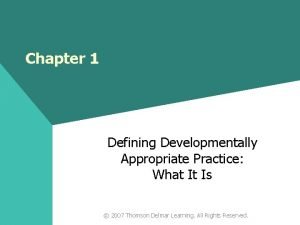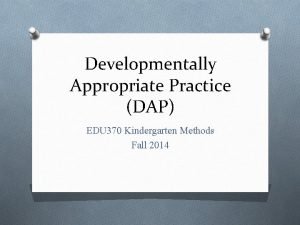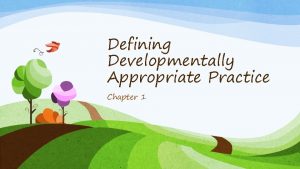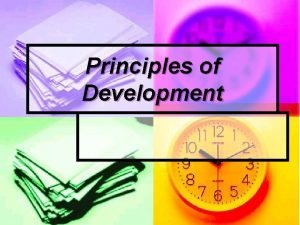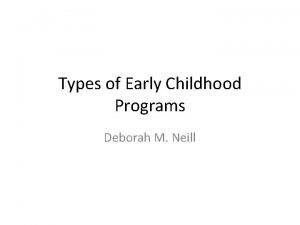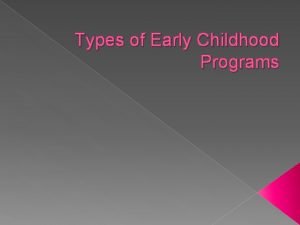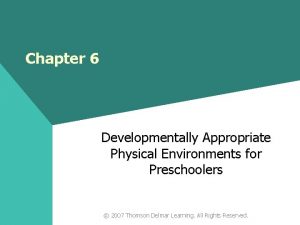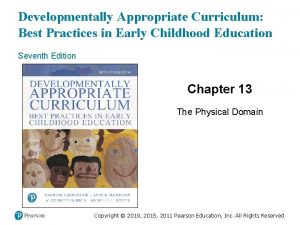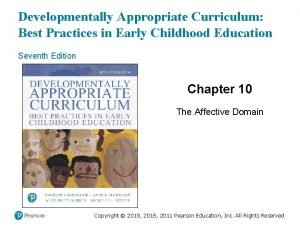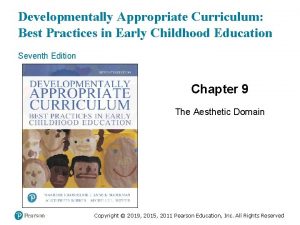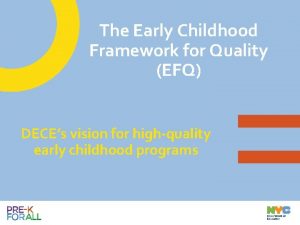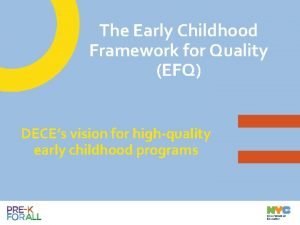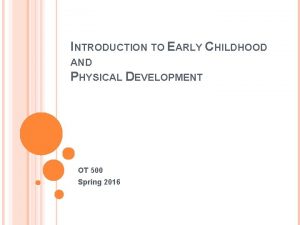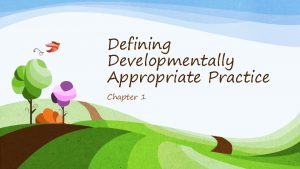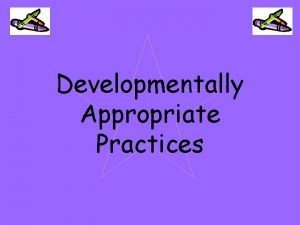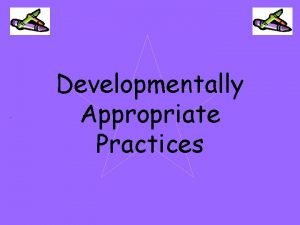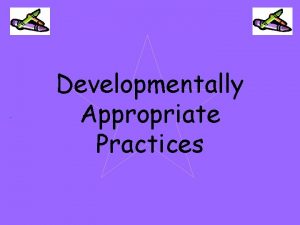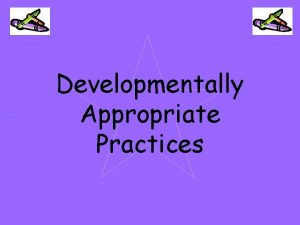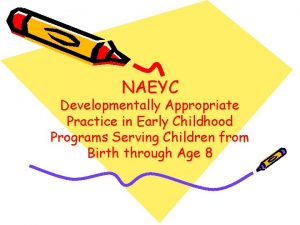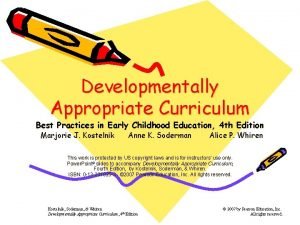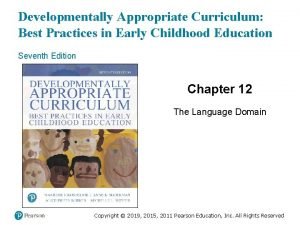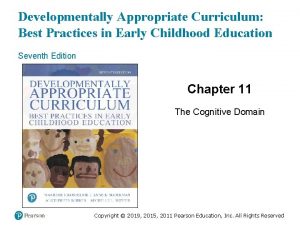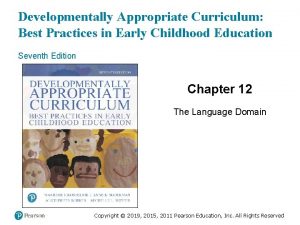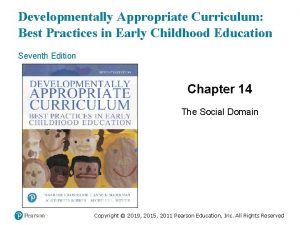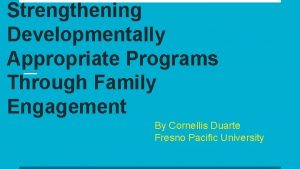Developmentally Appropriate Practice in Early Childhood Programs Serving




















- Slides: 20

Developmentally Appropriate Practice in Early Childhood Programs Serving Children from Birth through 8 A position statement of the National Association for the Education of Young Children Copyright © 1997. All rights reserved.

Developmentally appropriate practices Developmentally Appropriate Practice (DAP) informs the process of professionals making decisions about the well-being and education of children based on at least three important kinds of information or knowledge:

three important kinds of information or knowledge about DAP I. II. III. What is known about child development and learning What is known about the strengths, interests, and needs of each individual child in the group Knowledge of the social and cultural contexts in which children live

three important kinds of information or knowledge about DAP I. what is known about child development and learning— knowledge of age-related human characteristics that permits general predictions within an age range about what activities, materials, interactions, or experiences will be safe, healthy, interesting, achievable, and also challenging to children;

three important kinds of information or knowledge about DAP II. What is known about the strengths, interests, and needs of each individual child in the group to be able to adapt for and be responsive to inevitable individual variation;

three important kinds of information or knowledge about DAP III. knowledge of the social and cultural contexts in which children live to ensure that learning experiences are meaningful, relevant, and respectful for the participating children and their families.

TWELVE PRINCIPLES OF DAP 1. Domains of children’s development—physical, social, emotional, and cognitive—are closely related.

TWELVE PRINCIPLES OF DAP 2. Development occurs in a relatively orderly sequence, with later abilities, skills, and knowledge building on those already acquired.

TWELVE PRINCIPLES OF DAP 3. Development proceeds at varying rates from child to child as well as unevenly within different areas of each child’s functioning.

TWELVE PRINCIPLES OF DAP 4. Early experiences have both cumulative and delayed effects on individual children’s development; optimal periods exist for certain types of development and learning.

TWELVE PRINCIPLES OF DAP 5. Development proceeds in predictable directions toward greater complexity, organization, and internalization.

TWELVE PRINCIPLES OF DAP 6. Development and learning occur in and are influenced by multiple social and cultural contexts.

TWELVE PRINCIPLES OF DAP 7. Children are active learners, drawing on direct physical and social experience as well as culturally transmitted knowledge to construct their own understandings of the world around them.

TWELVE PRINCIPLES OF DAP 8. Development and learning result from interaction of biological maturation and the environment, which includes both the physical and social worlds that children live in.

TWELVE PRINCIPLES OF DAP 9. Play is an important vehicle for children’s social, emotional, and cognitive development, as well as a reflection of their development.

TWELVE PRINCIPLES OF DAP 10. Development advances when children have opportunities to practice newly acquired skills as well as when they experience a challenge just beyond the level of their present mastery.

TWELVE PRINCIPLES OF DAP 11. Children demonstrate different modes of knowing and learning and different ways of representing what they know.

TWELVE PRINCIPLES OF DAP 12. Children develop and learn best in the context of a community where they are safe and valued, their physical needs are met, and they feel psychologically secure.

Developmentally Appropriate Practice in Early Childhood Programs Serving Children from Birth through 8: A position statement of the National Association for the Education of Young Children (1997)

2009 Third Edition
 Define developmentally appropriate
Define developmentally appropriate Dap kindergarten
Dap kindergarten Define developmentally appropriate practice
Define developmentally appropriate practice Principles of developmentally appropriate practice
Principles of developmentally appropriate practice Middle and late childhood
Middle and late childhood Three types of early childhood programs
Three types of early childhood programs Chapter 2 types of early childhood programs
Chapter 2 types of early childhood programs Three types of early childhood programs
Three types of early childhood programs Developmentally appropriate environment
Developmentally appropriate environment Developmentally appropriate curriculum 7th edition
Developmentally appropriate curriculum 7th edition Developmentally appropriate curriculum 7th edition
Developmentally appropriate curriculum 7th edition Developmentally appropriate curriculum 7th edition
Developmentally appropriate curriculum 7th edition Cpmcd full form
Cpmcd full form Nyc doe efq
Nyc doe efq Early childhood framework for quality
Early childhood framework for quality Professional development program, rockefeller college
Professional development program, rockefeller college How to welcome parents in orientation
How to welcome parents in orientation Nsw department of education
Nsw department of education Leonard di vinci
Leonard di vinci Fine motor skills development in early childhood
Fine motor skills development in early childhood Trends in early childhood education
Trends in early childhood education
